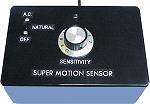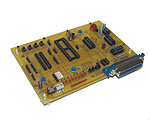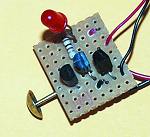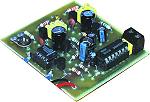| Projects in the May
2003 issue of EPE Magazine |

|
 Super
Motion Sensor - A highly responsive design that even detects a single
finger moving at five metres, or a person crossing a path at 20 metres
distance. Super-sensitive design, auto adjusts for ambient light levels.
Relay output. 12V d.c. supply. An interesting constructional project for
electronics hobbyists and experimenters. Super
Motion Sensor - A highly responsive design that even detects a single
finger moving at five metres, or a person crossing a path at 20 metres
distance. Super-sensitive design, auto adjusts for ambient light levels.
Relay output. 12V d.c. supply. An interesting constructional project for
electronics hobbyists and experimenters. |

|
 EPE PIC
Tutorial Version 2 (Part 2). Our fantastic PIC microcontroller tutorial
is absolutely the easiest low-cost way to learn about the techniques
needed for programming the PIC family of devices. The face of hobby
electronics is changing fast, and now you can be part of it by following
this superb 3-part tutorial written by John Becker. Designed to provide
extensive hand-holding even for complete beginners, there is really
no better way to climb on board and get to grips with PICs! Used in
conjunction with our PIC Toolkit Mk3 circuit board that connects directly
to a PC, this series is an enhanced revision of our highly acclaimed
series first published in 1998. Uses our free TK3 software for Windows
95, 98, Me. Can also run under NT, XP and 2000 using pointers and techniques
outlined in the article. EPE PIC
Tutorial Version 2 (Part 2). Our fantastic PIC microcontroller tutorial
is absolutely the easiest low-cost way to learn about the techniques
needed for programming the PIC family of devices. The face of hobby
electronics is changing fast, and now you can be part of it by following
this superb 3-part tutorial written by John Becker. Designed to provide
extensive hand-holding even for complete beginners, there is really
no better way to climb on board and get to grips with PICs! Used in
conjunction with our PIC Toolkit Mk3 circuit board that connects directly
to a PC, this series is an enhanced revision of our highly acclaimed
series first published in 1998. Uses our free TK3 software for Windows
95, 98, Me. Can also run under NT, XP and 2000 using pointers and techniques
outlined in the article.

In Part 2 of our bumper-sized supplement we play with switches, make
noise, count time periods and generally have fun with more PIC 16F84
commands.
 In
July 2003 issue (p.456) we said that on Page 31 of the PIC Tutorial
Part 2, In
July 2003 issue (p.456) we said that on Page 31 of the PIC Tutorial
Part 2,
the left-hand circuit notations shouldread top to bottom as RB0 to RB5.
|

|
 Earth
Resistivity Logger (Part 2) - Help your local archaeological society
to locate the hidden mysteries of our ancestors, using this versatile
but inexpensive measurement and logging system. Generates a 137 Hz ground-penetrating
signal. Realtime LCD display. PC compatible system, free Windows (95,
98, Me tested) software. Output exportable into Excel. Many more features
far too numerous to list here! Proven in field trials, this design offers
excellent performance for the price, with software to match. In Part 2,
we describe the PC software and offer general advice for budding archaeologists,
plus, details of an actual survey made using the EPE Earth Resistivity
Logger. Earth
Resistivity Logger (Part 2) - Help your local archaeological society
to locate the hidden mysteries of our ancestors, using this versatile
but inexpensive measurement and logging system. Generates a 137 Hz ground-penetrating
signal. Realtime LCD display. PC compatible system, free Windows (95,
98, Me tested) software. Output exportable into Excel. Many more features
far too numerous to list here! Proven in field trials, this design offers
excellent performance for the price, with software to match. In Part 2,
we describe the PC software and offer general advice for budding archaeologists,
plus, details of an actual survey made using the EPE Earth Resistivity
Logger. |
 |
Sample display of a PC screen using Earth Resistivity Logger software.

|

|
 Back
to Basics (Part4) - Live Wire Detector - our Back-to-Basics series
continues with more beginners' projects that offer you an opportunity
to build simple transistor designs and gain confidence in electronics
construction. The Live Wire Detector sounds a bleep when a live cable
is located, with no direct electrical contact needed. Also useful for
testing Christmas lights and initial mains fault finding tests. Back
to Basics (Part4) - Live Wire Detector - our Back-to-Basics series
continues with more beginners' projects that offer you an opportunity
to build simple transistor designs and gain confidence in electronics
construction. The Live Wire Detector sounds a bleep when a live cable
is located, with no direct electrical contact needed. Also useful for
testing Christmas lights and initial mains fault finding tests.
Back to Basics (Part 4) - Medium Wave (AM) Radio - just three
transistors are needed for producing this simple AM radio. The article
also describes the basics of amplitude modulation, the basis of fundamental
radio reception. Ferrite rod aerial. |
|
 |
 Door
Chime - the sound of the traditional 'ding dong' door bell is brought
to you once again, this time using an array of transistor oscillators
coupled to a small power amp i.c. to recreate the nostalgic sound. Door
Chime - the sound of the traditional 'ding dong' door bell is brought
to you once again, this time using an array of transistor oscillators
coupled to a small power amp i.c. to recreate the nostalgic sound.

|
|
|
Techno Talk describes how barcodes are
set to disappear! New Technology Update - how improved antenna
materials enhance mobile phone comms. Circuit Surgery - how to
read circuit diagrams (continued), and CMOS digital timing without glitches.
Ingenuity Unlimited - more readers' own ideas. Net Work
- the Internet column - how to win an Ebay auction in the closing seconds.
All this and more in the latest issue of EPE Magazine. Subscribe
now!
|
|
|







 In
July 2003 issue (p.456) we said that on Page 31 of the PIC Tutorial
Part 2,
In
July 2003 issue (p.456) we said that on Page 31 of the PIC Tutorial
Part 2,